Ever wonder why midwives and doulas swear by yoga balls during labor?
It’s not just hype. These bouncy spheres—also known as birthing balls—are more than just comfy seats for moms-to-be. When used intentionally, yoga ball exercises can reduce discomfort, open the pelvis, and even encourage your baby to descend properly. The result? A smoother, potentially faster labor.
Whether you’re in your second trimester or nearing the big day, integrating yoga ball exercises into your routine can be a game-changer. Let’s explore 7 powerful moves to help you feel stronger, more prepared, and confident about childbirth.

Table of Contents
Why Use a Yoga Ball During Pregnancy?
Before we dive into the exercises, here’s why yoga balls are a must for pregnant women:
- Improves posture by aligning your spine and pelvis
- Eases lower back pain and sciatic discomfort
- Encourages baby’s optimal position in the pelvis
- Supports gentle stretching and pelvic floor activation
- Relieves pressure from hips and ligaments
- Reduces anxiety and improves balance
Did You Know?
A birthing ball can help shorten the first stage of labor. A study published in the Journal of Obstetrics and Gynaecology Research found that women who used birthing balls experienced less pain and had a shorter duration of labor.
Yoga Ball Pregnancy Exercises: Do’s and Don’ts
| Do’s | Don’ts |
|---|---|
| Use a burst-resistant ball for safety. | Don’t use a ball that is too small or too big for your height. |
| Keep your feet flat and stable on the floor. | Don’t perform exercises on slippery surfaces. |
| Choose a ball that allows hips to stay higher than knees. | Don’t sit too low or hunch your back. |
| Move slowly and listen to your body’s signals. | Don’t rush or force movements that feel uncomfortable. |
| Practice near a wall or sturdy surface for balance. | Don’t attempt challenging positions alone, especially in late pregnancy. |
| Consult your healthcare provider before starting. | Don’t ignore signs of pain, dizziness, or shortness of breath. |
| Focus on breathing deeply while exercising. | Don’t hold your breath during movements. |
7 Best Yoga Ball Exercises To Do During Pregnancy
1. Pelvic Tilts (Rocking Back and Forth)
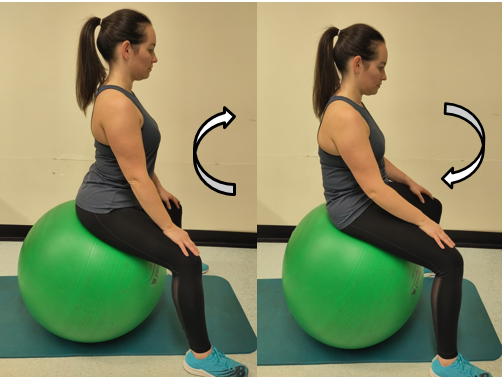
How to do it:
Sit on the yoga ball with your feet flat on the floor. Slowly tilt your pelvis forward and backward. Keep your shoulders relaxed and let your hips lead the movement.
Why it works:
This gentle movement loosens the lower back, reduces tension in the pelvic region, and can help guide your baby into a better position for birth.
Myth Buster:
Some believe sitting on a yoga ball can cause early labor. Not true. These exercises simply encourage better alignment and comfort, not contractions.
2. Hip Circles
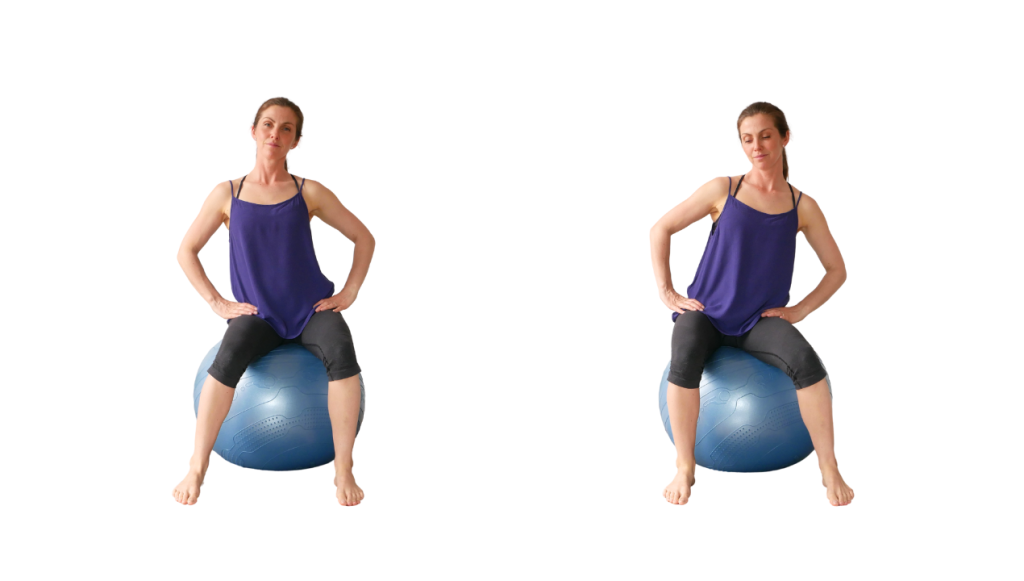
How to do it:
While seated, make large, slow circles with your hips in both directions. Keep your spine neutral and shoulders relaxed.
Why it works:
This motion stretches and opens the pelvic area. It improves flexibility and circulation, which may help labor progress more naturally.
Tip: Use this exercise during early labor to stay active and reduce anxiety.
3. Figure-Eight Movements
How to do it:
Just like hip circles, but this time move your hips in a figure-eight pattern. It might feel awkward at first, but it’s a powerful way to enhance mobility.
Why it works:
Figure-eights help create more space in the pelvic area, promoting better fetal positioning—crucial for a smoother delivery.
4. Gentle Bouncing
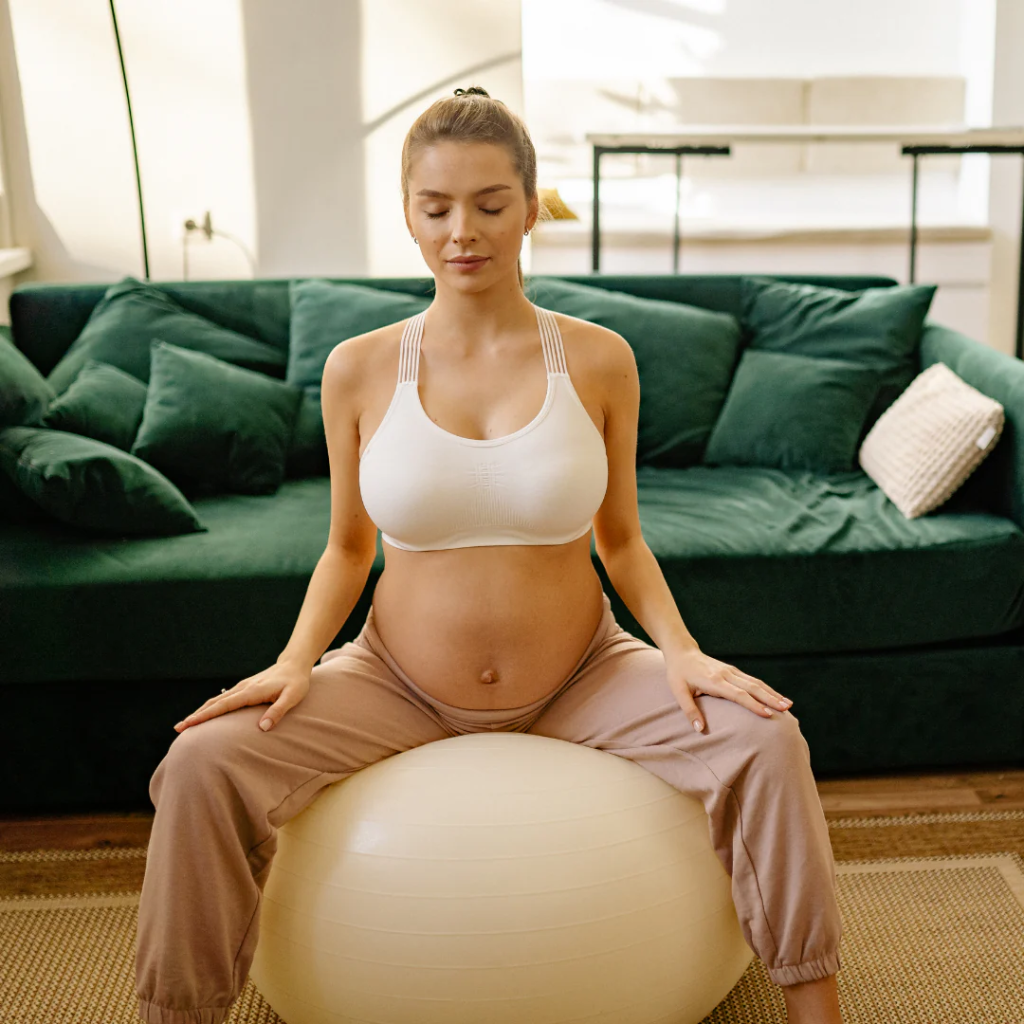
How to do it:
Sit on the ball and gently bounce up and down. Keep your feet grounded and your movements controlled.
Why it works:
Light bouncing boosts circulation and energy levels. It also helps your baby descend into the pelvis, preparing your body for labor.
Did You Know?
Bouncing on a yoga ball may stimulate the vagus nerve, which promotes relaxation and reduces stress—key during pregnancy and labor.
5. Wall-Supported Squats
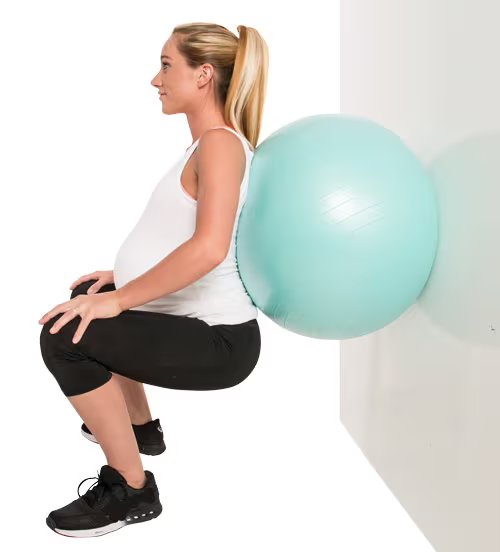
How to do it:
Place the yoga ball between your lower back and a wall. With feet hip-width apart, lower into a squat while keeping the ball in place. Rise slowly.
Why it works:
These squats strengthen the thighs and glutes while encouraging the pelvis to open. Plus, they build stamina for labor.
Safety Tip: Hold onto a sturdy chair or have a partner nearby for extra support.
6. Leaning Forward (Tabletop Support)
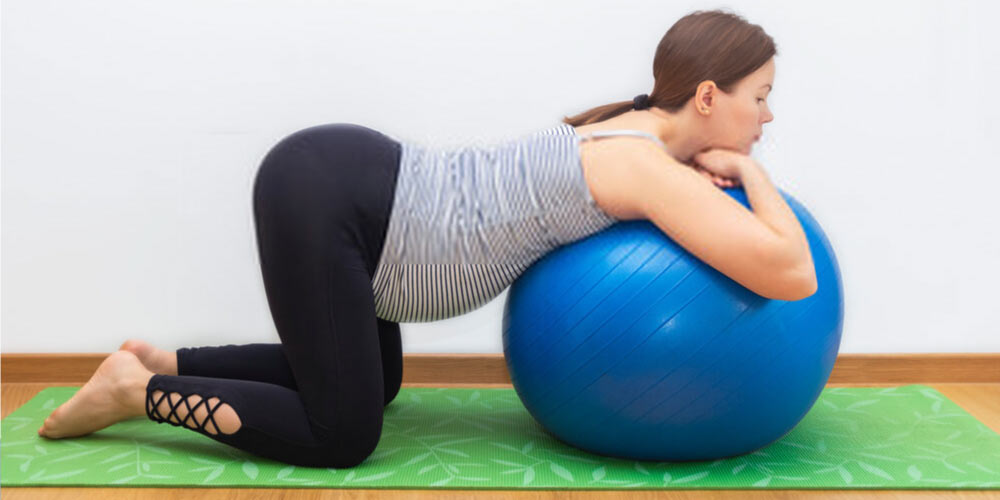
How to do it:
Kneel on the floor and lean your upper body forward onto the yoga ball. Rock gently side to side or back and forth.
Why it works:
This position relieves back pain, relaxes the hips, and helps the baby rotate into an optimal position for delivery—especially helpful if you’re experiencing back labor.
7. Butterfly Stretch on the Ball
How to do it:
Sit on the ball with feet together and knees apart (like butterfly wings). Gently press your knees toward the floor while sitting tall.
Why it works:
This stretch opens the hips and improves flexibility. It also relaxes the inner thighs and pelvic floor, making pushing easier during delivery.
Bonus: Deep Breathing with Ball Support
How to do it:
Sit or kneel, hug the ball, and rest your head on it. Inhale slowly through your nose and exhale fully through your mouth.
Why it works:
Combining breath with movement calms the nervous system and promotes a mindful connection with your body and baby.
Interesting Fact:
Deep breathing during pregnancy can reduce cortisol (stress hormone) levels and improve sleep quality.
When to Start Using a Yoga Ball
You can begin gentle yoga ball exercises in the second trimester, or as early as your healthcare provider gives the green light. As labor nears, these movements become more beneficial and supportive.
Precautions to Keep in Mind
- Always use a burst-resistant ball
- Make sure the ball is the right size for your height (hips should be slightly higher than knees)
- Don’t overdo it—listen to your body
- Stop if you feel dizzy, pain, or contractions
- Consult your healthcare provider before starting new exercises
Final Thoughts
Using a yoga ball during pregnancy isn’t just a trend—it’s a tried and true technique for preparing your body for one of life’s biggest moments. These seven simple exercises can help you feel empowered, reduce labor pain, and create a more positive birth experience.
So the next time you see a yoga ball, don’t just think of it as a workout tool. Think of it as your gentle, round companion on the journey to motherhood.
Ready to bounce your way to a smoother delivery?
Frequently Asked Questions (FAQs)
Is it safe to use a yoga ball during pregnancy?
Yes, using a yoga (birthing) ball is generally safe for most pregnant women, especially when used correctly and with guidance. However, always consult your doctor before starting any new exercise during pregnancy.
When should I start doing yoga ball exercises in pregnancy?
Most women can safely start in the second trimester (around 14–16 weeks). However, some begin earlier if they feel comfortable and have medical approval.
Can yoga ball exercises really make labor easier?
Yes! These exercises can help align the pelvis, encourage optimal baby positioning, and reduce muscle tension—all of which contribute to a smoother and possibly shorter labor.
How long should I do yoga ball exercises each day?
Start with 10–15 minutes per day and gradually build up to 30 minutes, depending on your energy levels and comfort.






Very good
Good
Awesome